This page contains references to diamonds or engagement rings from different companies. Sometimes I do receive a commission when you click on links and buy the products.
ASET is the abbreviated name for the Angular Spectrum Evaluation Tool. Created by the American Gem Society (AGS), this simple device can provide extensive details regarding the light handling properties of a diamond. As brilliance and fire are crucial factors contributing to the overall beauty of the diamond, ascertaining the finer details of light performance and cut quality is vital for choosing an excellent looking diamond.
ASET is not just a reflector tool, it is also the theoretical basis for American Gem Society Laboratories (AGSL) cut grading system based on light performance. Released by AGS in 2005, the grading system is one of the most advanced and scientifically stringent grading systems within the world of gemmology. The reflector device is used in conjunction with sophisticated diamond software; using ray tracing analysis, the ASET details light performance grading and can produce computer generated ASET imaging and other light maps pertaining to the diamond.
Understanding the ASET
The ASET concept is about unveiling important and specific details about the light handling properties of a diamond. The diamond is viewed through the top of a hemisphere that has been painted with colors that correlate to specific angular ranges. Looking through the ASET tool, the viewer will see the light appear in different colors depending on where the light is coming from. The tool will also indicate areas of light leakage; this occurs when areas of the diamond do not effectively return light. The light from the varying ranges of the horizon will have different attributes and thus the ASET can provide the necessary insights about the diamond’s ability to handle light.
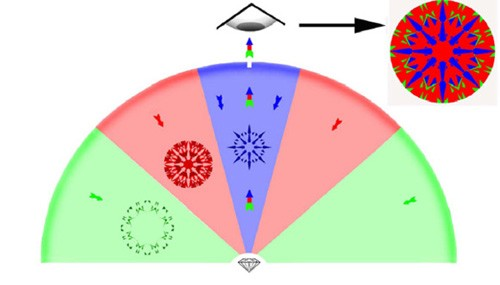
Image courtesy of Ideal-Scope.com
The angular ranges are as follows: 0-45 degrees (color coded in green), 45-75 (color coded in red), and 75-90 (color coded in blue). We see most things as lit from above, either by sunlight or artificial light, most of the direct light will enter a diamond from the higher angular ranges. The light from low angles tends to be indirect, i.e. reflected off of other objects surrounding the diamond, which means that it is less intense than the light entering from a higher angle. Light from the highest angular range, directly above, is blocked by the viewer when they are looking at the diamond at close range. This light is color coded as blue. This blue color may be assumed to be a negative quality within the diamond, suggesting darkness rather than light, however this shadowing, when it is balanced with the light, can have a positive impact on the appearance of a diamond. The dark shadow (sometimes referred to as obscuration) provides contrast against the light areas, creating the ‘twinkle’ we see in diamonds, known as scintillation.
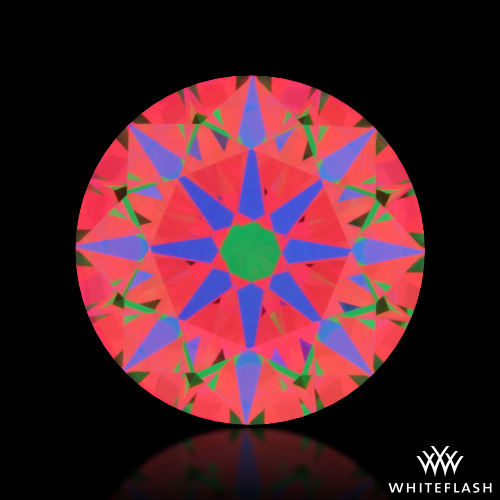
Image courtesy of Whiteflash
A well-cut diamond will show all of the colors coded on the ASET. The dominant color will be red, with a small amount of green, a symmetrical and balanced pattern of blue, and minimal light leakage.
Here is an image of a diamond with light performance issues:
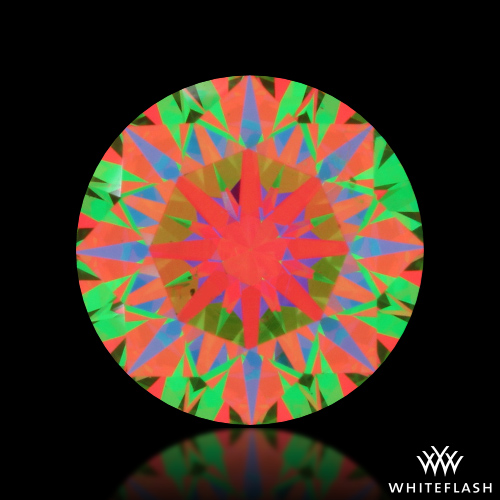
Image courtesy of Whiteflash
An ASET analysis can be applied to any shape of diamond and subsequent grading systems can be formed for each of them. At present, the AGSL has developed these grades for Round, Princess, Emerald Cut and Oval diamonds, as well as certain forms of the cushion cut diamond. The nature of fancy cut diamonds makes them more variable. An ASET of fancy shaped diamonds can give a clearer understanding of how these diamond shapes handle light, and what is desirable.
The ASET Device
The ASET tool takes several forms. The main difference between the ASET viewers is regarding light leakage; backlit versions will present light leakage as white, while tools utilising a dark background will present light leakage as black.
Among these forms are the desktop, presentation and handheld models.
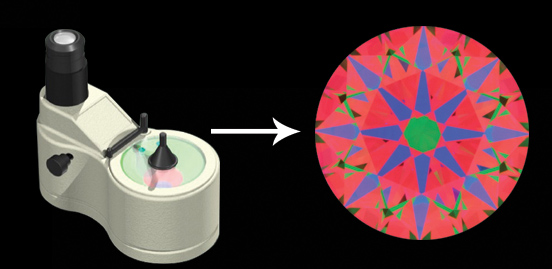
This is a desktop tool. The diamond is placed upside down on the glass with the table flat. Then the black cover is placed over the diamond to give the black background (which will show light leakage as black). Inside the device are a set of mirrors, which bounce the image and project it to the viewing window and to the viewers eye.
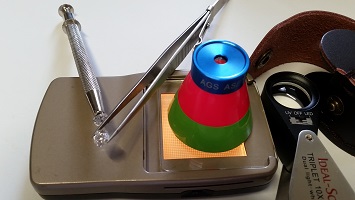
Image courtesy of Ideal-Scope.com
This is a handheld model. Although this version can take a little more practice to master, it is highly functional and portable tool, allow the viewer to inspect diamonds with ease. It can be used with or without the portable light source. The diamond can be viewed in an upright position and backlighting will cause light leakage to appear as white.
Computer Generated ASET Grades and Imaging
The AGS light performance grading system hinges on the ASET process, and this is integrated into the software. This process of grading the diamond begins with a ray tracing of a precise 3D model of the diamond; this process measures the facets of the diamond and can evaluate light leakage, as well as brightness, fire and contrast. This software can also produce ASET images of the diamond and some AGSL reports will include ASET light maps.
A Platinum AGSL report can be order with one or two light maps which present both the table and pavilion ASET views of the graded diamond. Two light maps are most commonly presented on reports of high precision diamonds as they allow hearts and arrows patterning to be clearly identified, along with a general view of light performance.
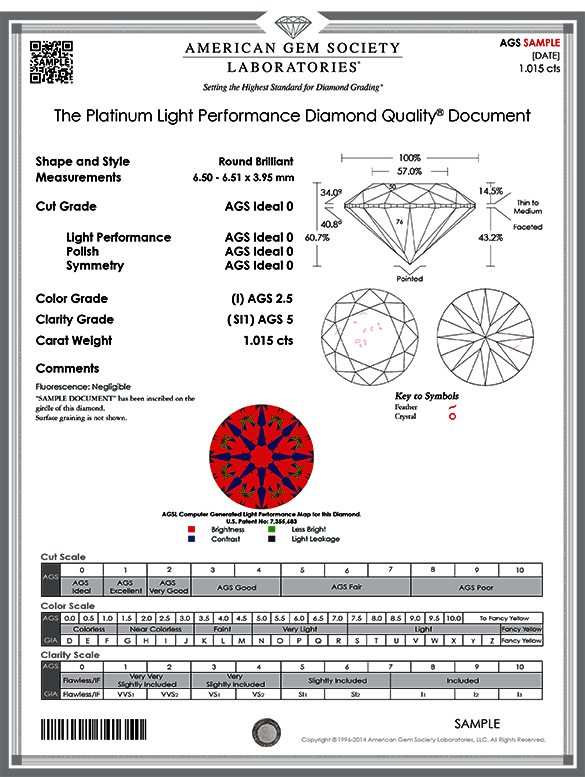
Single ASET Light Map on a Platinum Report
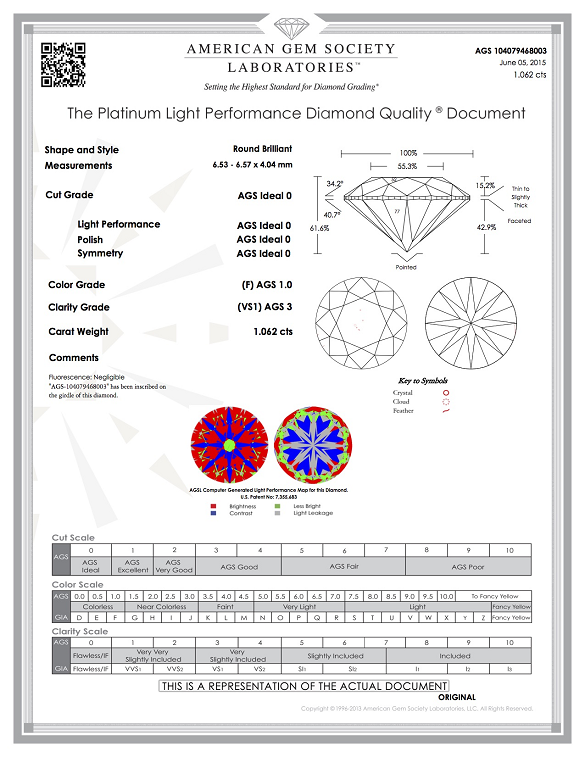
Dual ASET Light Maps on a Platinum Report
ASET images can also be provided by independent AGS software and other computer programmes such as Octonus’ DiamCalc. In the absence of ‘real’ images of the diamond, some merchants may present ASET images.
While it is often said there is no substitute for a high-res image of the diamond you are viewing, an ASET image can provide a wealth of information about the performance, and subsequently the appearance of a diamond. The nature of the ASET framework is founded upon a precise mathematical structure making them a reliable and accurate representation of the diamond. The efficacy of an ASET map largely depends upon the precision of the scan and the readers ability to interpret the images and understand the data. Always consider the source of computer generated ASETS and ASET photos to ensure the information is accurate as possible.
Ideal Scope
The Ideal Scope is a reflector tool which can be used to assess light leakage and basic symmetry in a diamond. While it is founded on similar principles to ASET, it does not offer the same level of detail regarding the quality of light return in a diamond. It is a helpful, slightly rudimental tool, which is often a great starting point for assessing the light handling properties of a diamond.
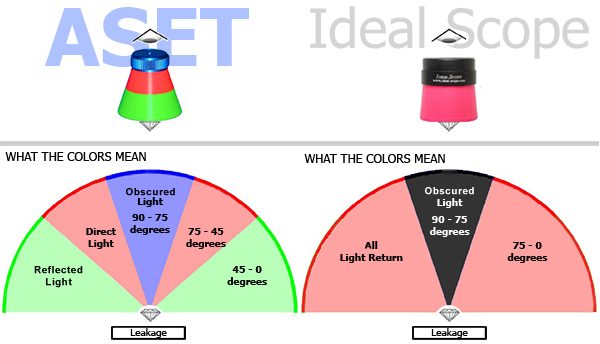
When using an Ideal Scope, the light re-tuning to the eye appears in red, light leakage appears as white and obscuration (the shadow caused by the viewer) appears as black.
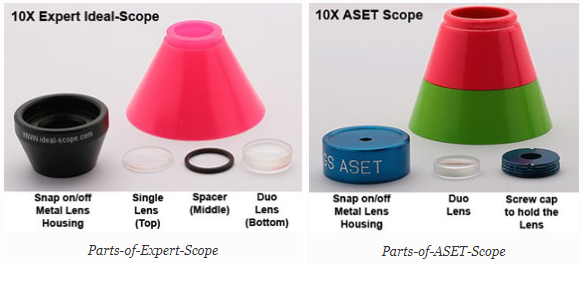
Images courtesy of Ideal-Scope.com
The Final Word
The theoretical framework of ASET and its various applications are an accessible way to gain valuable insight into the light performance of a diamond. As it can be applied to any shape of diamond and is fairly simple to understand, it is an excellent tool for buyers looking to optimize their purchase with a firm understanding and representation of a diamonds light returning abilities.

Richard Jenkins, The Diamond Guru
Get free assistance from the Diamond Guru today. You’ll be glad you did!
- Secure the best quality diamond for your budget.
- Don’t pay over the odds for your diamond ring.
- Have peace of mind that you didn’t get ripped off.
Have a Question? Contact us now…

